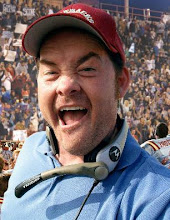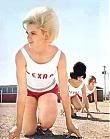Post by brophy on Feb 3, 2006 10:56:17 GMT -6
Grayshirting gets more attention, gives schools, athletes more options
By Steve Batterson
While it is a first for the Iowa football program, the grayshirt option that Davenport Central football player Julian Vandervelde is pursuing is not that uncommon.
“I had never heard of it until the Iowa coaches mentioned it to me,’’ Vandervelde said. “It’s something different, and I’m not sure it’s for everybody, but I feel like it should help me.’’
In essence, grayshirting involves promising a recruit a scholarship but asking him or her to delay full-time enrollment into college until the second semester of the student’s freshman year.
It can work several ways.
As Vandervelde plans to do, the student can enroll part time at the school he or she intends to sign with, taking no more than 11 hours of courses during the first semester. During that time, the student cannot practice with the team, be involved in supervised workouts or attend any practice that is not normally open to the general public.
He could have taken two other routes.
The student can enroll at a junior college or another institution anywhere in the country and take classes on a part-time basis, and then transfer after the first semester, or the student can sit out the first semester, continuing to work or train at home before enrolling in classes for the first time in the second semester.
The grayshirt option differs from the early-enrollment option which also has increased in popularity in recent years.
Iowa State’s Jason Scales and Illinois’ E.B. Halsey graduated early from high school and enrolled in college at midyear in order to participate in spring practices before the rest of their freshman classmates arrived on campus.
“I did miss out on a lot — prom, graduation, all of those senior things — but it was the best way to prepare me to compete in the fall,’’ Scales said. “It’s not for everybody. I think it’s an individual deal and for me, it was the best way to go.’’
The difference between the two is that early-enrollment gives athletes five seasons to play four, while grayshirting extends an athlete’s career, providing an extra season of developmental time before the athlete begins that five-year window to play four seasons.
There is, in theory, some risk involved. The school is under no obligation to fulfill its promise of a scholarship if no letter of intent has been signed, although coaches believe backing out of a verbal agreement would lead to an advantage for rival recruiters.
“There has to be some trust involved,’’ Vandervelde said. “When (Iowa assistant coach Reese) Morgan talked about the possibility of the grayshirt, and they offered the scholarship, I knew they would follow through with their promise. It’s a Big Ten school, and I believe they will be true to their word.’’
The risk, however, can lead to a reward.
Minnesota Vikings linebacker Raonall Smith became the first grayshirt in the Pac-10 when he sat out a semester after high school before enrolling at Washington State in 1997, and former New York Giants offensive lineman Omar Smith was a grayshirt recruit at Kentucky.
The use of the grayshirt option has increased over the past decade, particularly on the West Coast and in the Southeast.
It has been used by some newly hired coaches to quickly fill needs. Mike Shula at Alabama, for instance, brought in three grayshirt players in 2004, and Dave Wannstedt extended his initial recruiting class at Pittsburgh by doing the same.
The grayshirt option has been used rarely in the Big Ten, but Penn State has been averaging about two grayshirt recruits per year, and at least two freshmen quarterbacks on rosters last season were beginning careers after grayshirting.
Kevin Suhey of Penn State and David Ramirez of Purdue graduated from high school in 2004 but did not enroll at their colleges until last January. Both redshirted last season and will have four years of eligibility remaining.
By Steve Batterson
While it is a first for the Iowa football program, the grayshirt option that Davenport Central football player Julian Vandervelde is pursuing is not that uncommon.
“I had never heard of it until the Iowa coaches mentioned it to me,’’ Vandervelde said. “It’s something different, and I’m not sure it’s for everybody, but I feel like it should help me.’’
In essence, grayshirting involves promising a recruit a scholarship but asking him or her to delay full-time enrollment into college until the second semester of the student’s freshman year.
It can work several ways.
As Vandervelde plans to do, the student can enroll part time at the school he or she intends to sign with, taking no more than 11 hours of courses during the first semester. During that time, the student cannot practice with the team, be involved in supervised workouts or attend any practice that is not normally open to the general public.
He could have taken two other routes.
The student can enroll at a junior college or another institution anywhere in the country and take classes on a part-time basis, and then transfer after the first semester, or the student can sit out the first semester, continuing to work or train at home before enrolling in classes for the first time in the second semester.
The grayshirt option differs from the early-enrollment option which also has increased in popularity in recent years.
Iowa State’s Jason Scales and Illinois’ E.B. Halsey graduated early from high school and enrolled in college at midyear in order to participate in spring practices before the rest of their freshman classmates arrived on campus.
“I did miss out on a lot — prom, graduation, all of those senior things — but it was the best way to prepare me to compete in the fall,’’ Scales said. “It’s not for everybody. I think it’s an individual deal and for me, it was the best way to go.’’
The difference between the two is that early-enrollment gives athletes five seasons to play four, while grayshirting extends an athlete’s career, providing an extra season of developmental time before the athlete begins that five-year window to play four seasons.
There is, in theory, some risk involved. The school is under no obligation to fulfill its promise of a scholarship if no letter of intent has been signed, although coaches believe backing out of a verbal agreement would lead to an advantage for rival recruiters.
“There has to be some trust involved,’’ Vandervelde said. “When (Iowa assistant coach Reese) Morgan talked about the possibility of the grayshirt, and they offered the scholarship, I knew they would follow through with their promise. It’s a Big Ten school, and I believe they will be true to their word.’’
The risk, however, can lead to a reward.
Minnesota Vikings linebacker Raonall Smith became the first grayshirt in the Pac-10 when he sat out a semester after high school before enrolling at Washington State in 1997, and former New York Giants offensive lineman Omar Smith was a grayshirt recruit at Kentucky.
The use of the grayshirt option has increased over the past decade, particularly on the West Coast and in the Southeast.
It has been used by some newly hired coaches to quickly fill needs. Mike Shula at Alabama, for instance, brought in three grayshirt players in 2004, and Dave Wannstedt extended his initial recruiting class at Pittsburgh by doing the same.
The grayshirt option has been used rarely in the Big Ten, but Penn State has been averaging about two grayshirt recruits per year, and at least two freshmen quarterbacks on rosters last season were beginning careers after grayshirting.
Kevin Suhey of Penn State and David Ramirez of Purdue graduated from high school in 2004 but did not enroll at their colleges until last January. Both redshirted last season and will have four years of eligibility remaining.








